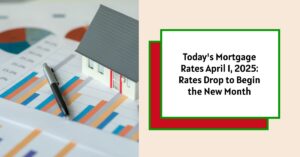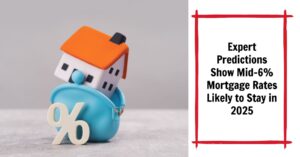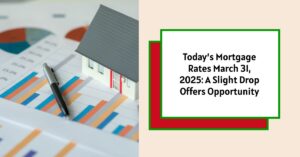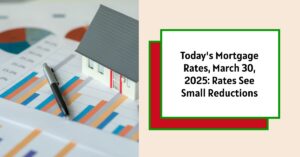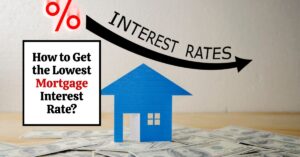Ever feel like you're trapped in a game show, anxiously watching mortgage rates rise and fall with every spin of the wheel? We've all been there! The truth is, understanding what causes those numbers to dip can feel like deciphering ancient hieroglyphics.
But what if we told you it doesn't have to be that complicated?
This comprehensive guide delves into the intricate dance of economics and market forces that influence mortgage rates, empowering you to navigate the home-buying process with confidence.
What Makes Mortgage Rates Go Down: Market Forces at Play
The Starring Cast: Key Players Influencing Mortgage Rates
Before we dive into the “why,” let's meet the key characters in our mortgage rate drama:
- The Federal Reserve: Like the conductor of an orchestra, the Fed sets the tempo for interest rates through its monetary policy.
- Inflation: This economic villain can send rates soaring when it rears its ugly head.
- Economic Growth: A healthy economy is like a rising tide that lifts all boats, including mortgage rates.
- Investor Demand: The bond market, where mortgage-backed securities are traded, plays a crucial role in determining rates.
- Loan Types: Different mortgage products come with their own set of interest rate dynamics.
Now, let's unravel how each of these factors influences the ups and downs of mortgage rates.
Unmasking the Culprits: Factors that Drive Mortgage Rates Down
1. The Federal Reserve: Lowering the Benchmark
- The Fed Funds Rate: Imagine a giant faucet controlling the flow of money in the economy. The Fed Funds Rate is the valve that dictates how much banks charge each other for overnight loans. When the Fed lowers this rate, it creates a ripple effect, pushing down borrowing costs across the board, including mortgage rates.
- Quantitative Easing (QE): Think of QE as the Fed injecting a dose of financial adrenaline into the economy. By purchasing mortgage-backed securities and other assets, the Fed injects liquidity into the market, driving down long-term interest rates, including those on mortgages.
Example: During the economic uncertainty of the COVID-19 pandemic, the Federal Reserve implemented aggressive rate cuts and QE measures, leading to historically low mortgage rates.
2. Taming the Inflation Beast
- Inflation's Grip: Imagine inflation as a sneaky tax that eats away at your purchasing power. When prices rise too quickly, lenders demand higher interest rates to offset the erosion of their returns. Conversely, when inflation cools down, mortgage rates tend to follow suit.
- The Consumer Price Index (CPI): This economic indicator tracks the average change in prices paid by urban consumers for a basket of goods and services. A slowing CPI signals easing inflation, potentially leading to lower mortgage rates.
Example: In 2023, the Federal Reserve has been raising interest rates to combat high inflation, leading to upward pressure on mortgage rates.
3. Economic Growth: Finding the Sweet Spot
- Goldilocks Economy: A strong economy is like a well-oiled machine, but if it overheats, inflation can surge. Conversely, a sluggish economy can stifle demand and lead to lower interest rates. Lenders seek a “Goldilocks” economy—one that's growing at a sustainable pace without sparking inflation.
- Gross Domestic Product (GDP): This measure of the total value of goods and services produced in a country serves as a barometer for economic health. Slowing GDP growth can signal a weakening economy, potentially pushing mortgage rates down.
Example: During the 2008-2009 recession, the U.S. economy contracted sharply, leading to a decline in mortgage rates as demand for housing plummeted.
4. Investor Demand: The Bond Market Connection
- Mortgage-Backed Securities: Imagine bundling thousands of mortgages together and selling shares to investors. That's essentially what mortgage-backed securities (MBS) are. When investors flock to the relative safety of MBS, demand pushes up prices, which, in turn, drives down mortgage rates.
- Flight to Safety: During times of economic uncertainty, investors often seek refuge in safe-haven assets like U.S. Treasury bonds. This “flight to safety” can lower Treasury yields, which often influence mortgage rates.
Example: The 2011 European sovereign debt crisis led to a flight to quality, with investors pouring money into U.S. Treasury bonds. This, in turn, pushed down Treasury yields and mortgage rates.
5. Loan Type: Each with Its Own Rhythm
- Fixed-Rate Mortgages: Like a steady ship, fixed-rate mortgages offer predictable monthly payments over the life of the loan. These rates are generally influenced by long-term economic factors and bond market yields.
- Adjustable-Rate Mortgages (ARMs): Think of ARMs as roller coasters, with rates that fluctuate based on market conditions. ARMs typically start with a lower introductory rate than fixed-rate mortgages, but their rates can adjust higher or lower over time.
Example: During periods of rising interest rates, ARMs may seem attractive due to their lower initial rates. However, borrowers should be aware that their rates could rise significantly if market conditions change.
Riding the Wave: Strategies for Securing a Lower Mortgage Rate
Understanding the factors that influence mortgage rates is half the battle. Here are some savvy strategies to help you secure a more favorable rate:
- Boost Your Credit Score: Think of your credit score as a financial report card. A higher score signals to lenders that you're a responsible borrower, making you eligible for lower interest rates.
- Increase Your Down Payment: A larger down payment reduces the lender's risk, potentially qualifying you for a lower rate.
- Shop Around for the Best Rates: Don't settle for the first mortgage offer you receive. Comparing rates from multiple lenders can save you thousands of dollars over the life of your loan.
- Lock in Your Rate: Once you've found a favorable rate, consider locking it in to protect yourself from potential rate increases before closing.
- Consider Points: Mortgage points allow you to “buy down” your interest rate by paying an upfront fee at closing.
The Crystal Ball: Predicting Future Mortgage Rate Trends
While predicting the future of mortgage rates is about as reliable as forecasting the weather, several factors suggest potential trends:
- The Fed's Balancing Act: The Federal Reserve's ongoing efforts to combat inflation will likely continue to influence interest rates in the near term.
- Geopolitical Uncertainty: Global events, such as the war in Ukraine and ongoing supply chain disruptions, can create volatility in financial markets, impacting mortgage rates.
- Housing Market Dynamics: Inventory levels, demand, and affordability will continue to shape the trajectory of mortgage rates.
Key Takeaway: While predicting the future of mortgage rates with certainty is impossible, staying informed about economic trends, monitoring market indicators, and seeking guidance from financial professionals can empower you to make informed decisions.
Summary:
Navigating the world of mortgage rates doesn't have to be a daunting task. By understanding the key players and forces at play, you can approach the home-buying process with confidence. Remember, knowledge is power, and armed with the insights from this guide, you'll be well-equipped to secure a favorable mortgage rate and unlock the door to your dream home.
- Will Mortgage Rates Ever Be 3% Again: Future Outlook
- Mortgage Rates Predictions for Next 2 Years
- Mortgage Rate Predictions for Next 5 Years
- Mortgage Rate Predictions for 2025: Expert Forecast
- Prediction: Interest Rates Falling Below 6% Will Explode the Housing Market
- Mortgage Rate Predictions: Why 2% and 3% Rates are Out of Reach
- How Lower Mortgage Rates Can Save You Thousands?
- How to Get a Low Mortgage Interest Rate?
- Will Mortgage Rates Ever Be 4% Again?

